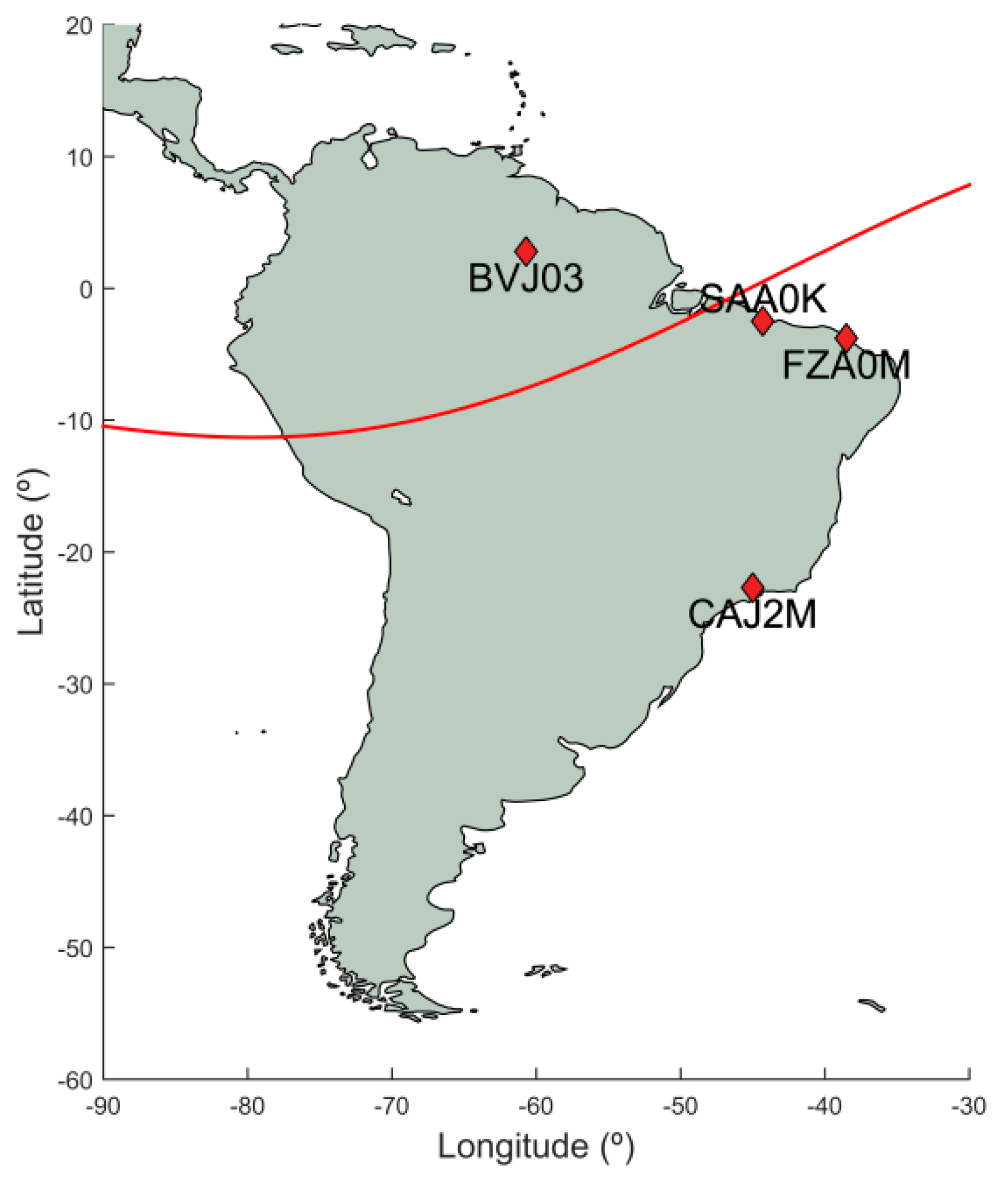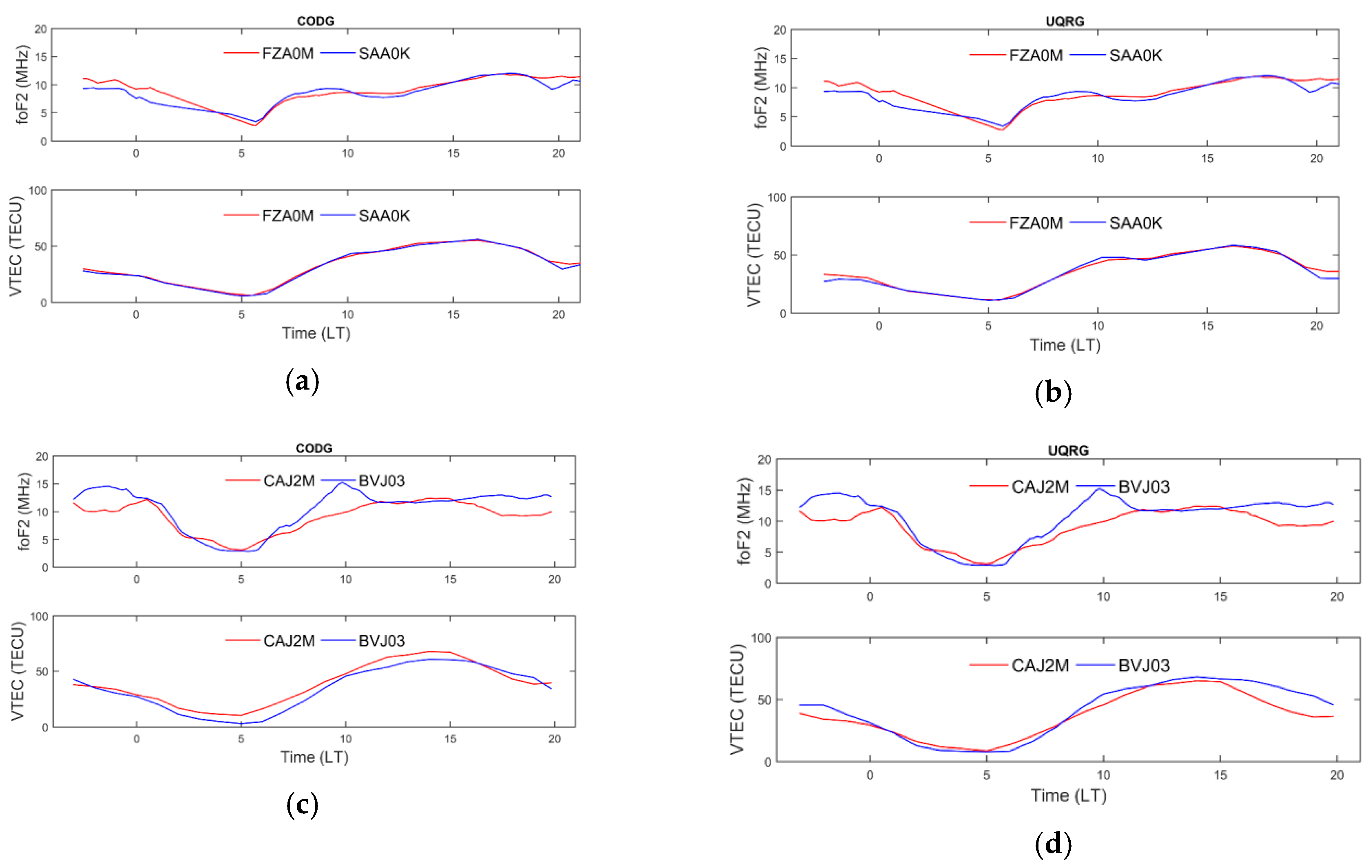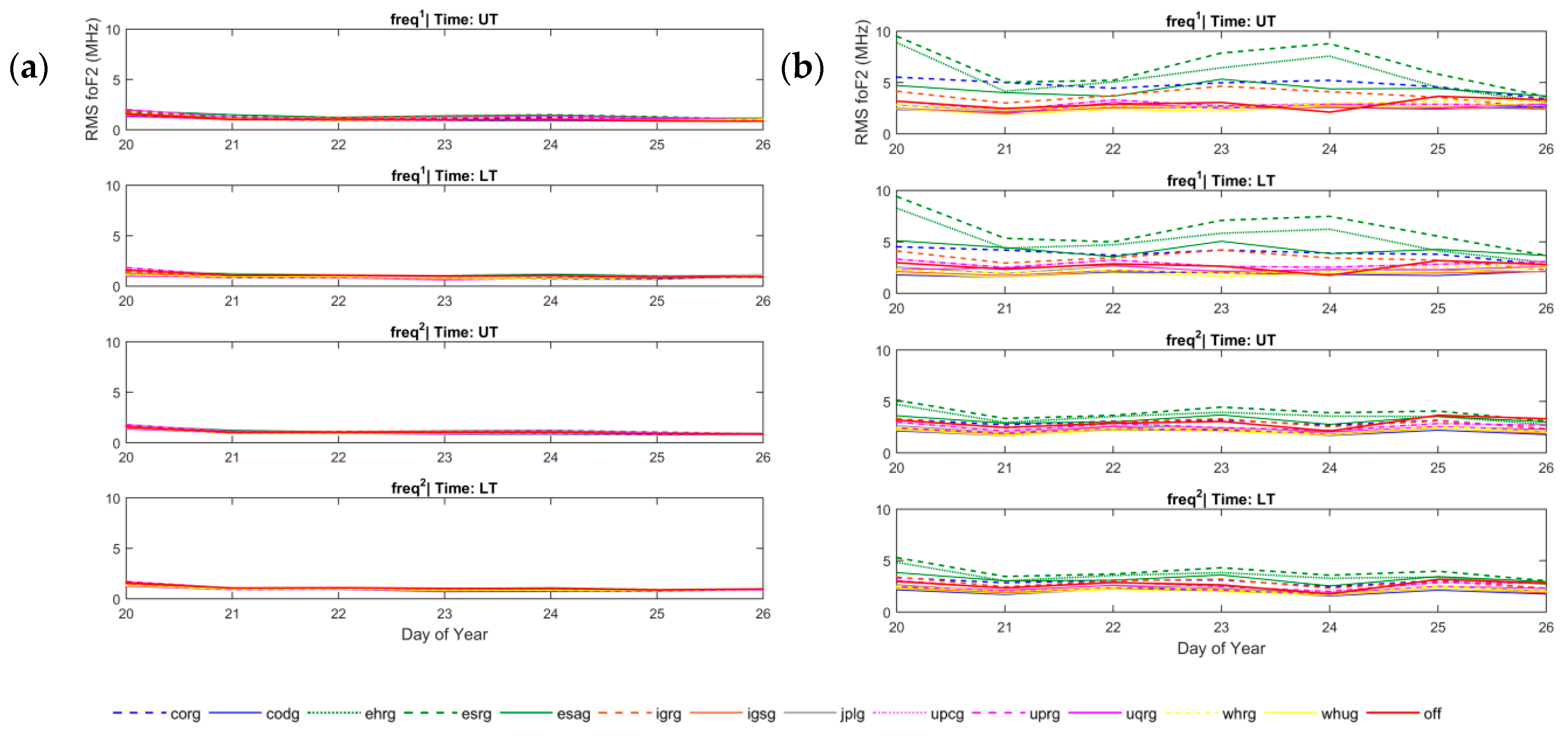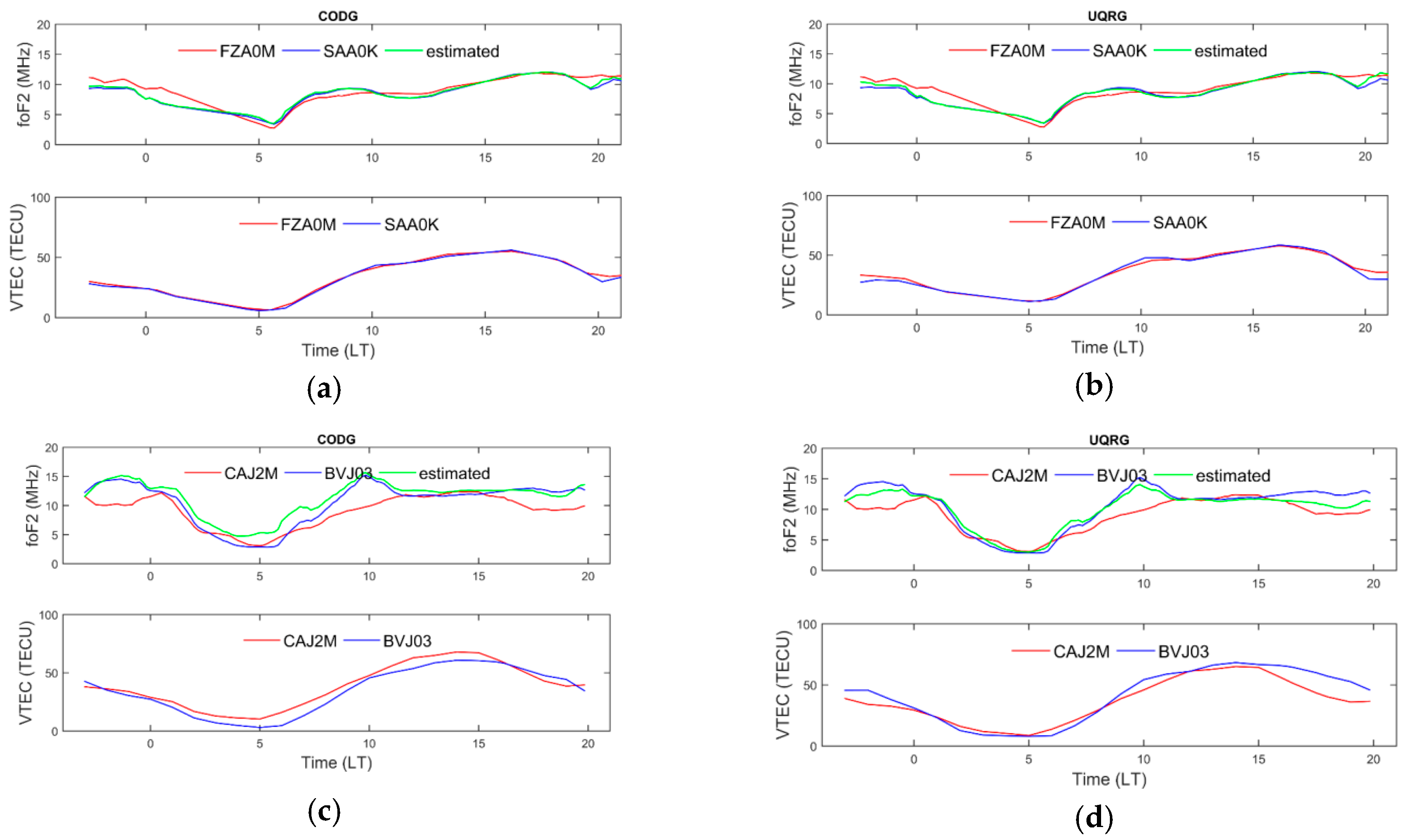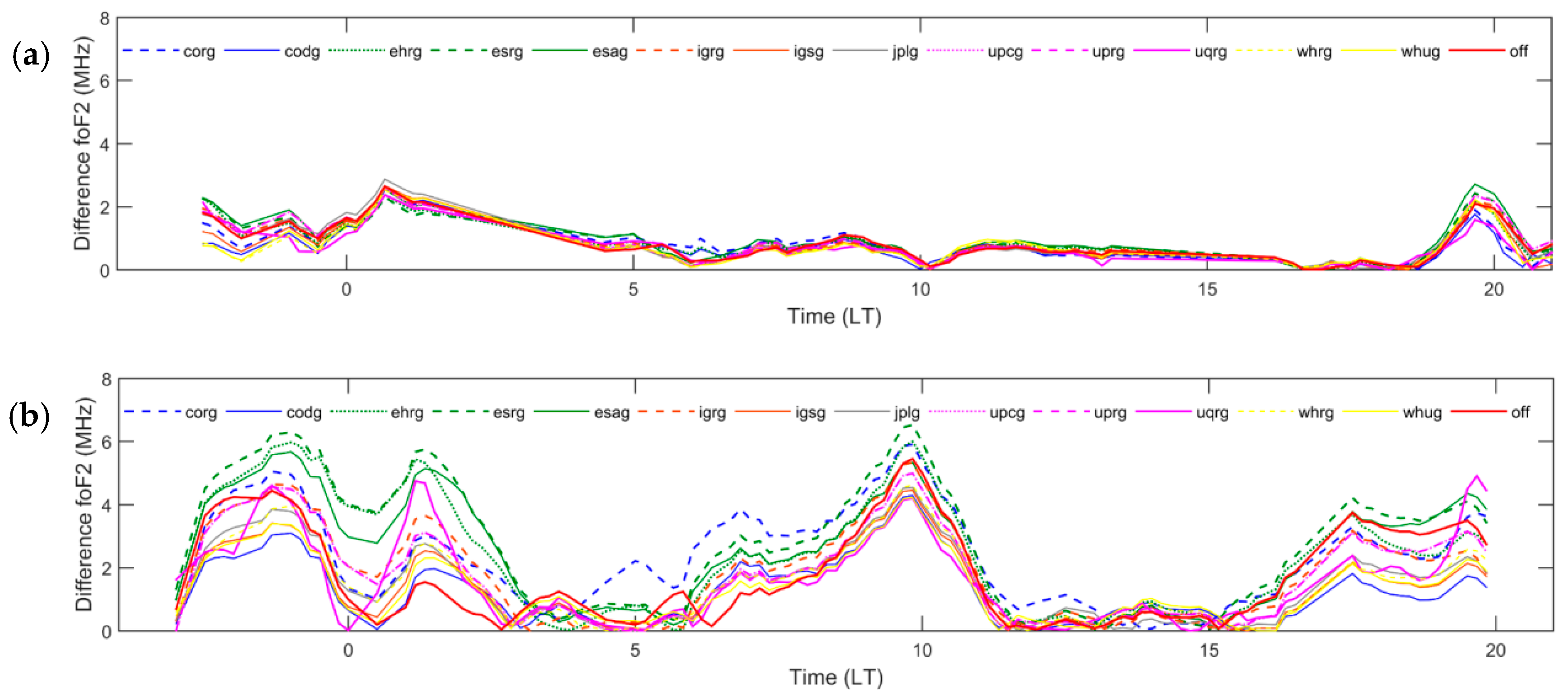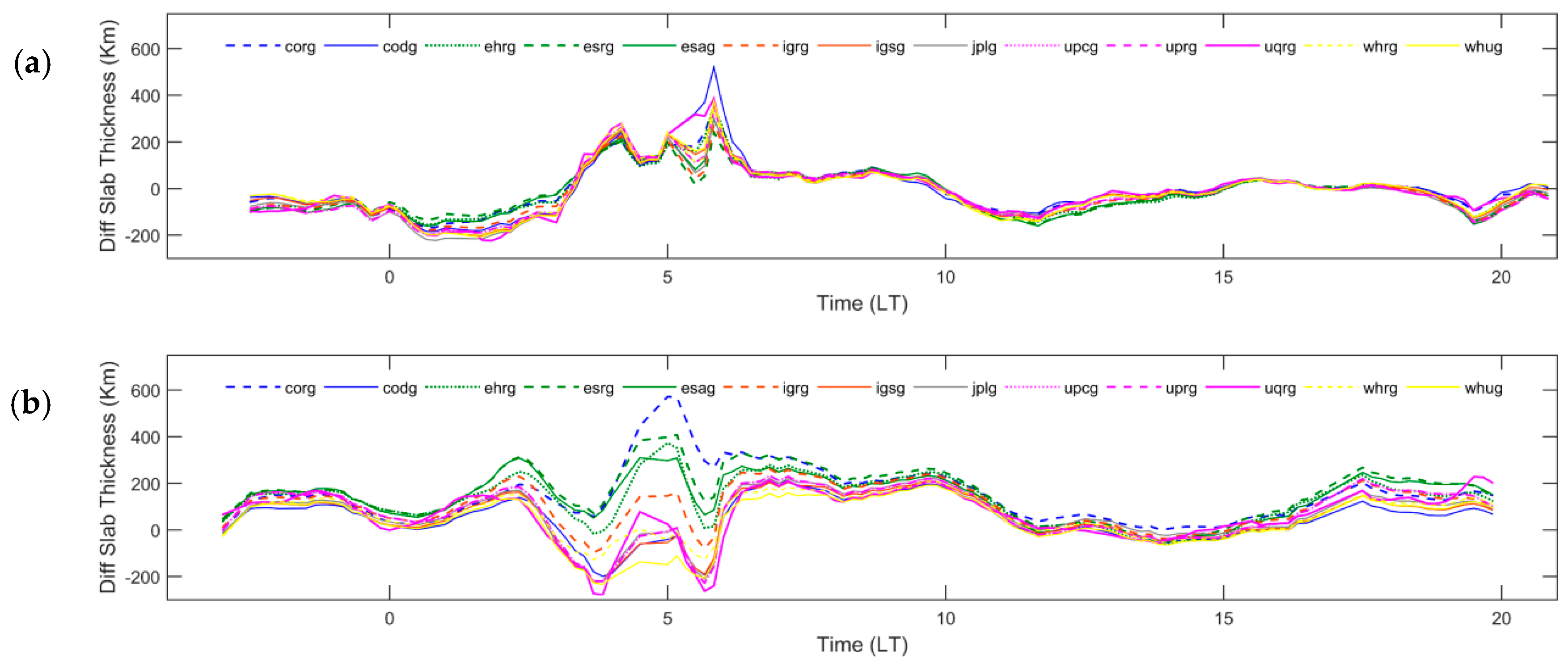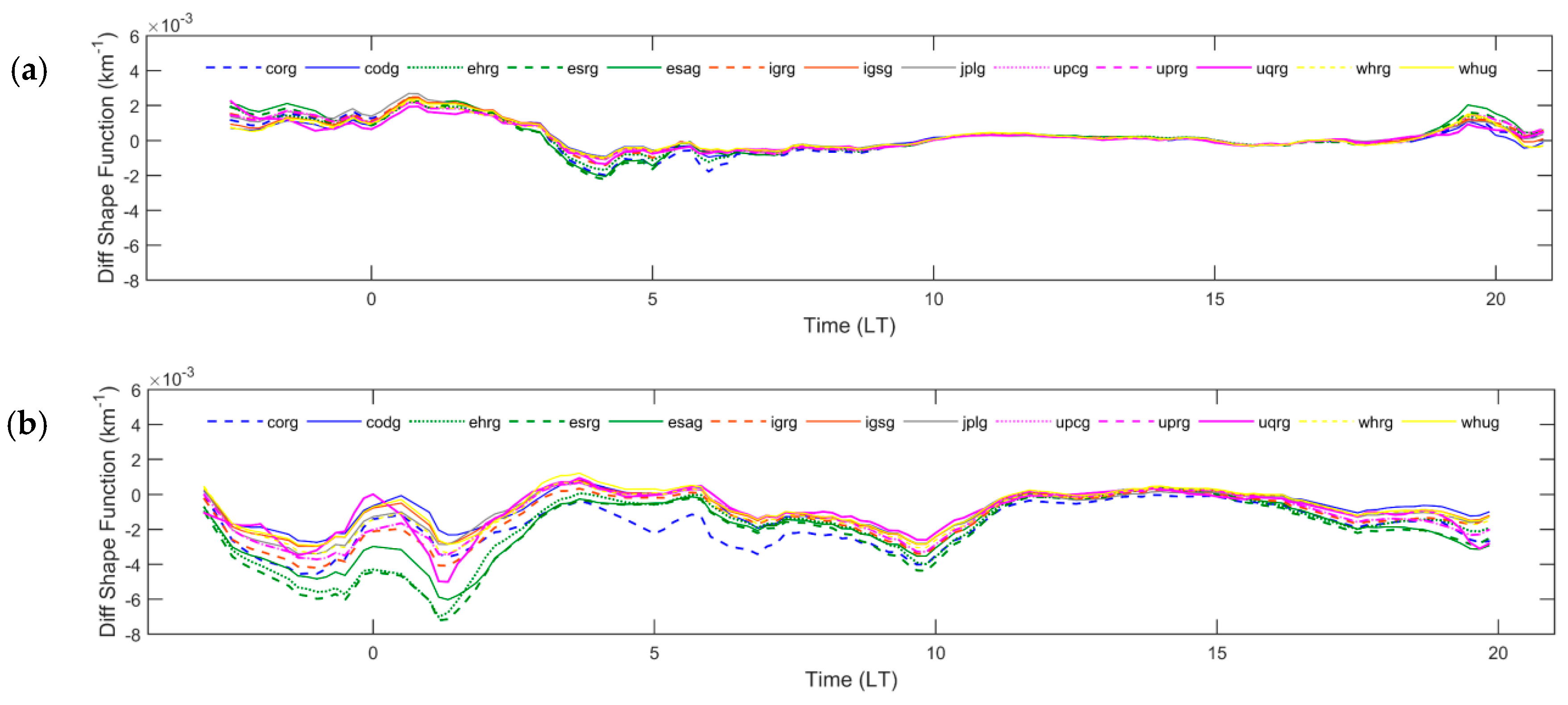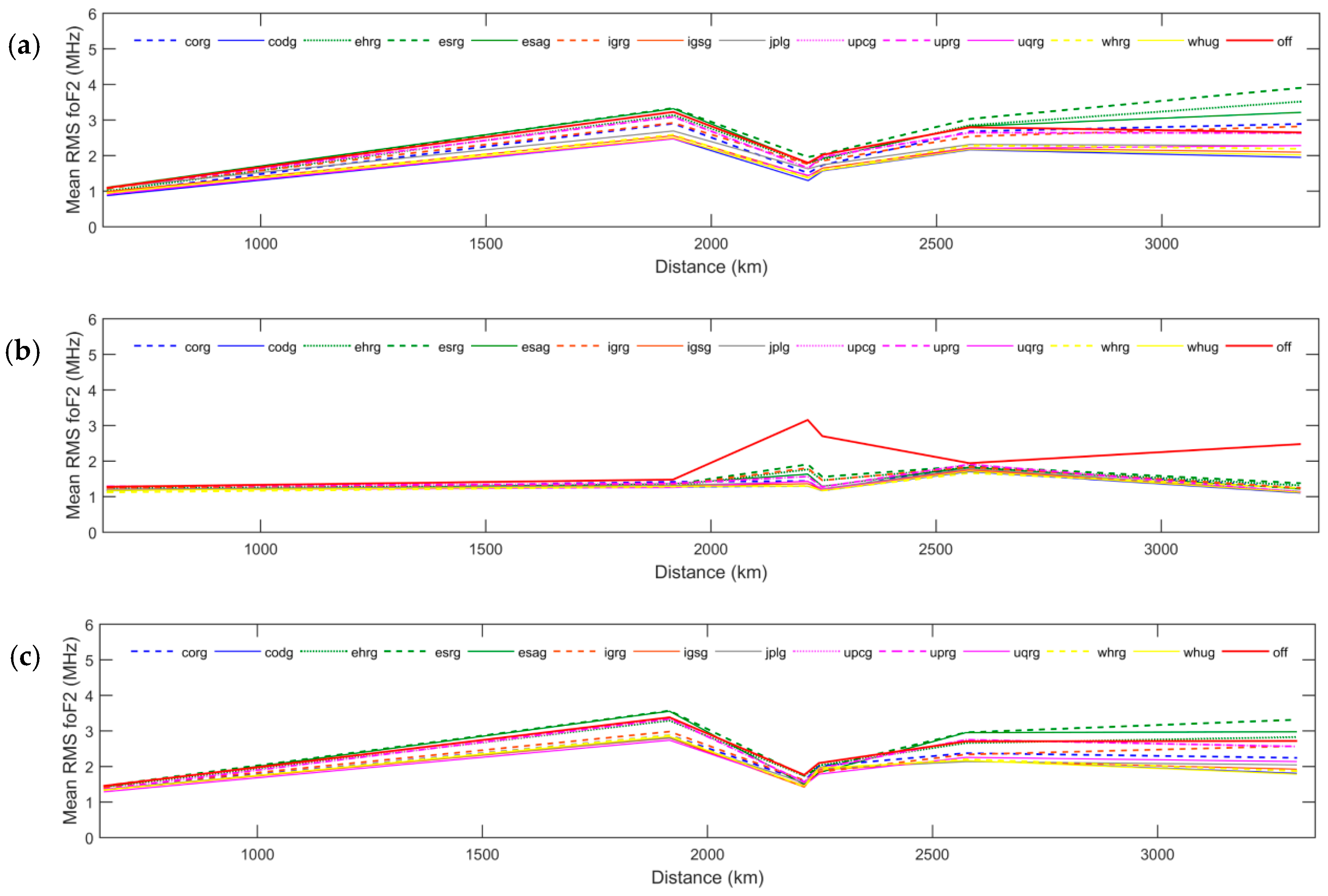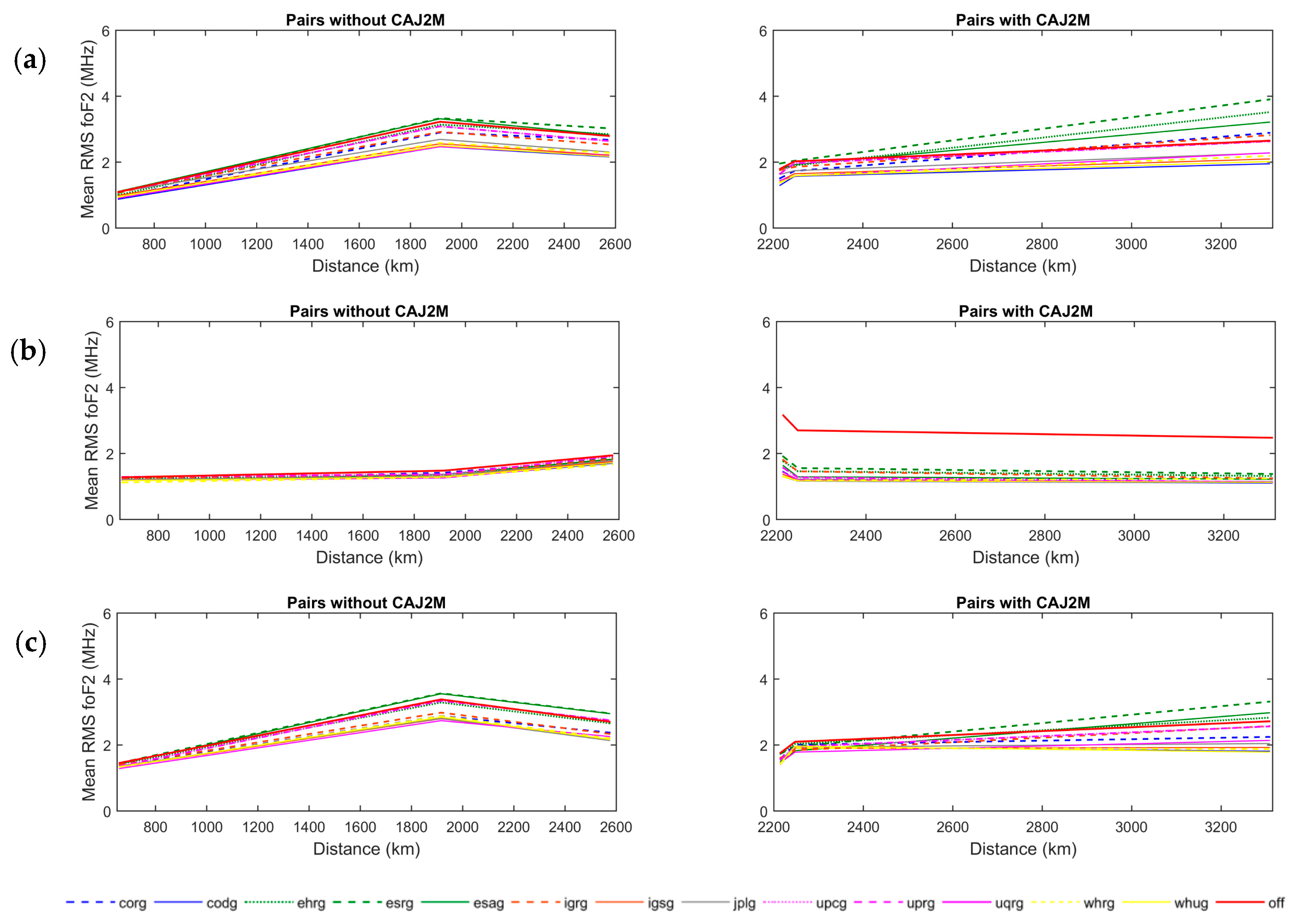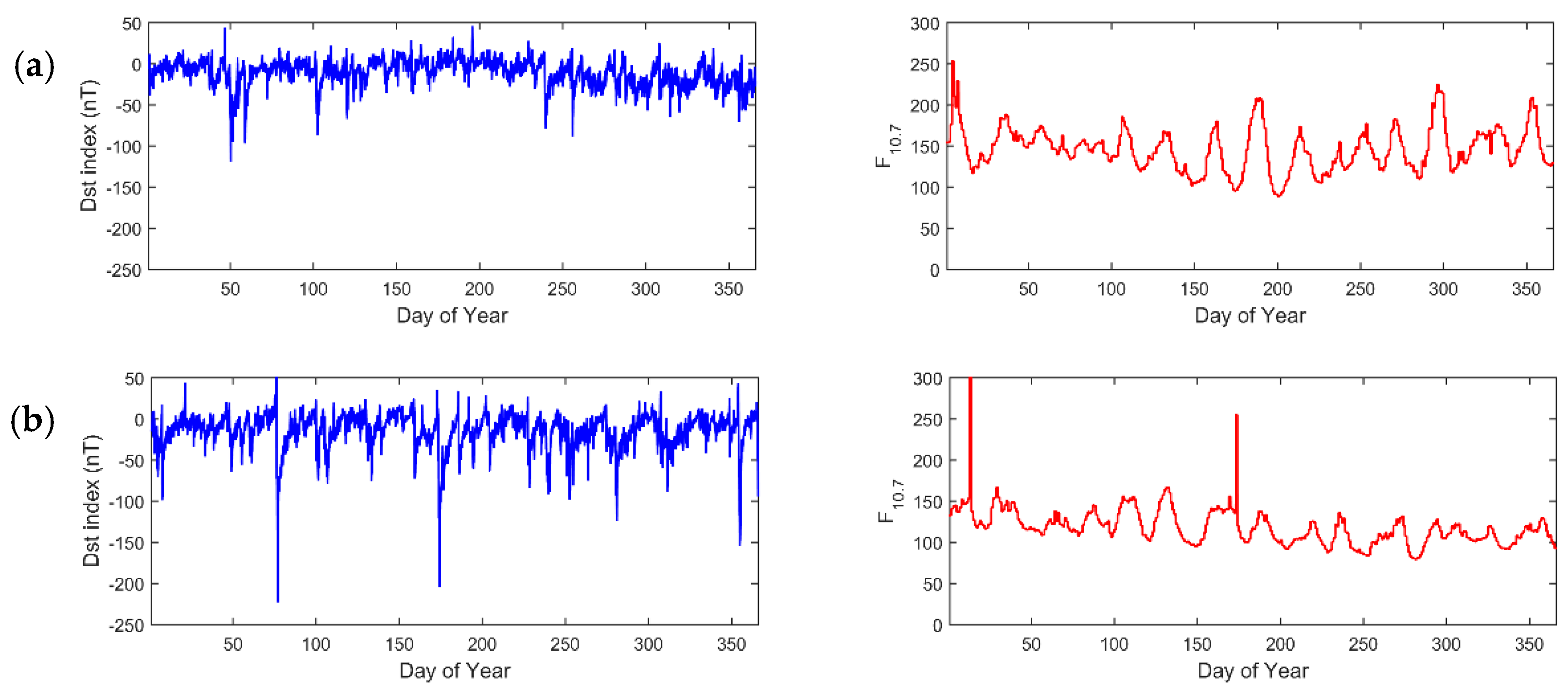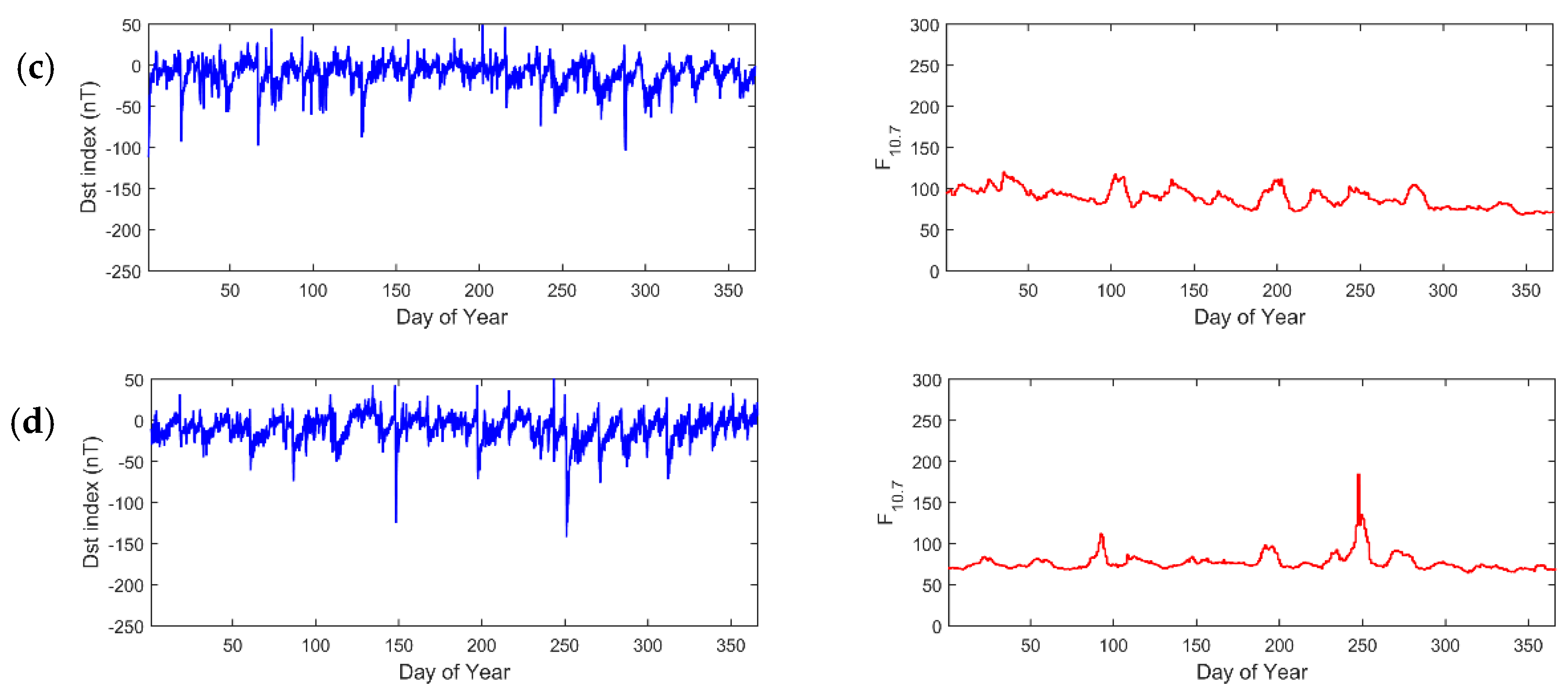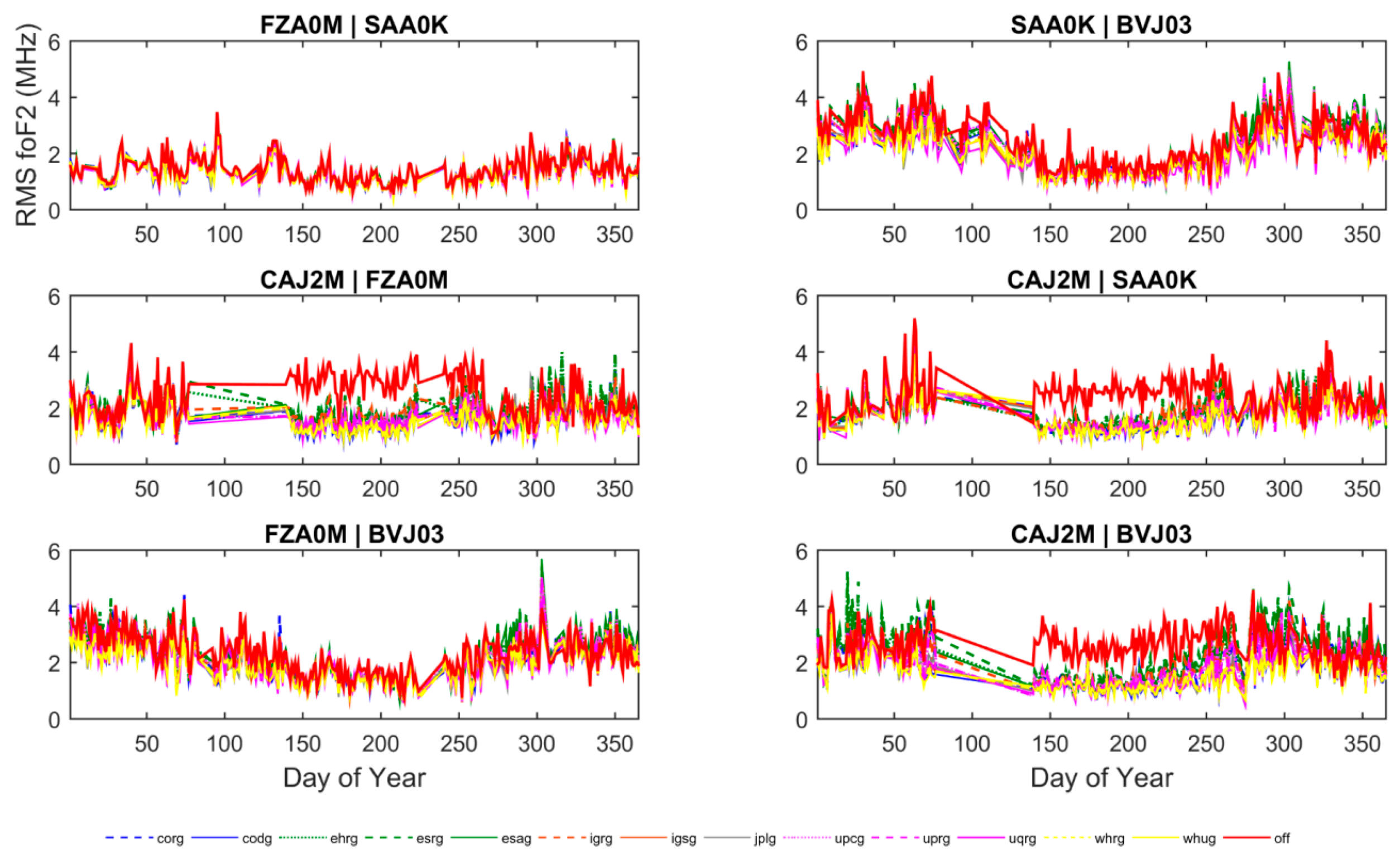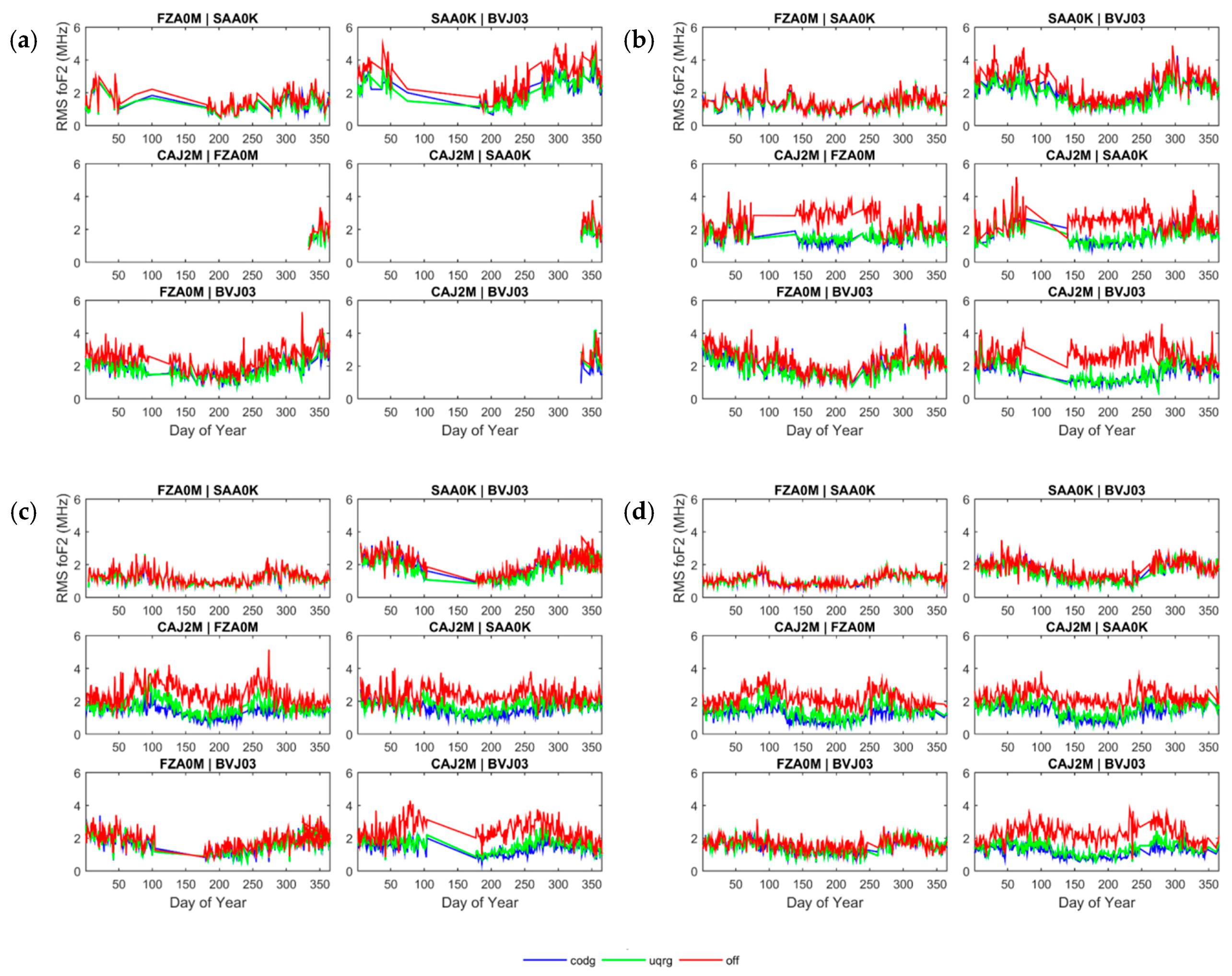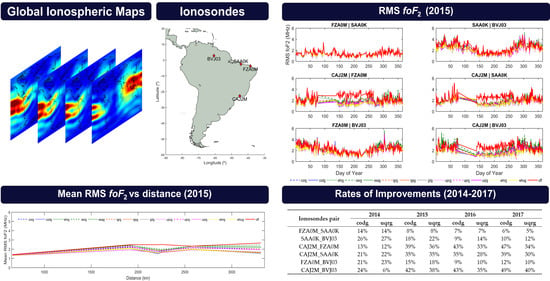1. Introduction
Vertical total electron content (VTEC) based on GNSS (Global Navigation Satellite System) measurements has been one of the main parameters used to describe the ionosphere. Given such valuable information, many efforts have been made in the last few decades to provide reliable VTEC values in terms of global ionospheric maps (GIMs). Since 1998, for instance, several Ionosphere Associated Analysis Centers (IAACs) from IGS (International GNSS Service) have developed methods to provide GIMs [
1]. Some of the main analysis centers are established by CODE (Center for Orbit Determination in Europe), ESA (European Space Agency), JPL (Jet Propulsion Laboratory), UPC (Universitat Politècnica de Catalunya), and WHU (Wuhan University). Despite all methods are based on VTEC inputs provided by GNSS measurements, the quality of each product varies, depending mainly on the modeling process, DCB (Differential Code Bias) computation, and shell-model specification [
2].
The quality of ionospheric models is commonly defined based on comparisons with reference values from consolidated ionospheric models such as IRI (International Reference Ionosphere [
3]) [
4,
5,
6], IGS GIMs [
7,
8,
9], ionosonde data [
10,
11,
12], and VTEC values from altimeter and GNSS data [
13,
14,
15]. In the case of GIMs, mostly of the validation and assessment methods are based on comparison with two complementary sources of reference data: VTEC measurements from altimeters and STEC (slant TEC) variability from independent GNSS receivers. Previous studies related to GIMs assessment concerning this approach can be found in Hernández-Pajares et al. [
14] and Roma-Dollase et al. [
2], indicating the quality and consistency of IGS GIMs.
A complimentary assessment to benefit the quality indicators of GIM’s accuracy would be the incorporation of ionosonde measurements as a reference to specify the “true” ionosphere. The electron density peak in the F
2 layer (
NmF
2) is commonly measured by ionosondes in terms of the associated critical frequency (
foF
2), which is specially trustable when they are directly provided from manually calibrated ionosonde datasets [
16]. Some studies related to the estimation of
foF
2 can be found in works such as Altinay et al. [
17] and Pietrella et al. [
18].
Several investigations regarding the comparison of VTEC with
foF
2 have been performed. Spalla and Ciraolo [
19] investigated the calibration of Faraday Rotation measurements by the slab thickness. In this work, the correlation between VTEC and
foF
2 is analyzed with a limitation of the assumption of constant slab thickness, used during nighttime over long periods (long enough to allow sufficient points to statistics, but short enough to avoid long periods effects caused by variations of slab thickness). Leitinger et al. [
20] present an analysis of the relations between VTEC and
foF
2 at regular and extreme behaviors, highlighting the influence of slab thickness for estimating VTEC based on
foF
2 or vice versa, considering mid-latitudes. Kouris et al. [
21] present a study of the variation of VTEC and
foF
2 values, showing a clear correlation between them, specifically when low/medium solar activity periods are considered. A study correlating VTEC and
foF
2, and using
foF
2 to predict VTEC, by means of linear regression, was conducted by Cander [
22]. Some papers applied the relation between VTEC and
foF
2 to perform ionospheric analysis at global [
23] and regional approaches [
24,
25]. In addition, VTEC and
foF
2 relations have also been used for improving climatological models, see for instance Habarulema et al. [
11] and Pignalberi [
26]. However, there is still room for the definition of a systematic GIMs quality assessment based on
foF
2 measurements.
Considering the relevance of assessing GIMs and the consistency of
foF
2 from ionosonde data, we present a new GIM assessment method. The assessment is based on how much VTEC from GIM can help in the interpolation of directly measured and manually scaled
foF
2 considering periods and regions with variable slab thickness (
Section 2). We have applied this strategy in one of the most challenging ionospheric scenarios, which comprehends the most recent solar maximum (2014) at low latitudes. Results of the proposed method are presented in
Section 3, the discussion in
Section 4, and
Section 5 shows the conclusions.
2. Materials and Methods
The assessment of the IGS GIMs has been carried out using ionospheric products available at the Crustal Dynamics Data Information System (CDDIS). The VTEC global ionospheric maps selected for this study are indicated in
Table 1. They are provided in IONEX (ionosphere map exchange) format by IGS [
27], in two different latencies and correspondingly different availability of receivers: rapid (1–2 days) and final (1–2 weeks). More information about GIM products can be found for instance in Hernandez-Pajares et al. [
1] and Roma-Dollase et al. [
2].
Data from four ionosondes (digisondes from Lowell Digisonde International) (
Figure 1) of the Brazilian National Institute for Space Research (INPE, acronym in Portuguese) were used: BVJ03 located in Boa Vista-RR (2.8N, 60.7W; 12.9N magnetic latitude), SAA0K in São Luiz-MA (2.5S, 44.3W; 0.8S magnetic latitude), FZA0M in Fortaleza-CE (3.8S, 38.5W; 5.5S magnetic latitude) and CAJ2M in Cachoeira Paulista-SP (22.7S, 45.0W; 16.4S magnetic latitude). Ionosonde data are available at the Space Weather Data Share, of Brazilian Study and Monitoring of Space Weather (EMBRACE/INPE) program [
28]. In this study, only manually scaled
foF
2 data were used with a 10-min time resolution.
The peculiarity of our validation method is that we form a pair of ionosonde stations. The
foF
2 variability of the ionosphere between both stations is considered as relatively close to the VTEC variability. To this end,
Table 2 presents the selected pairs of ionosonde stations with their respective distances.
We have applied the assessment method at different time series: one week; one year and four years. The first analysis aimed to select the assessment strategy with better performance, using one-week data from 2015 with the six possible ionosonde pair combinations (
Table 2) and all the rapid and final GIMs (
Table 1). In the second assessment, after the selection of the best strategy, we extended the application of this method for a one-year time series (2015), assessing all GIMs previously used. The third assessment was conducted with two of the products with the best performance in the 2015 time series, CODG and UQRG, considering a four-year time series (2014-2017).
The method of assessment proposed in this paper is based on the correlation between the critical frequency at the F
2 layer and the VTEC [
19,
20,
21].
Figure 2 presents plots comparing the behavior of
foF
2 measured by two pairs of ionosondes and the respective VTEC values estimated using two GIM products (CODG and UQRG) for the ionosonde positions. Values presented correspond to the day of year (DOY) 21 of 2015. It can be noticed that
foF
2 and VTEC in general present a clear similarity. Some specific behaviors of
foF
2 are not always well represented by VTEC but we assume that the quality depends on the GIM product.
In the proposed GIM assessment method, data from one ionosonde () is estimated based on data from the other ionosonde of the considered pair (). The VTEC variation between both places is used to transport the foF2 from ionosonde 2 to the location of the ionosonde 1. In this way, estimated foF2 can be compared with the real foF2 measured at the first ionosonde (), and, implicitly, the GIM quality can be assessed in front of a manually scaled foF2 measurement.
The GIM assessment was based on the root mean square (RMS) of the differences between the values of
foF
2 measured at the first station (
) and the values estimated with GIMs (
):
where
is the number of values estimated.
The assessment also considered the normalized root mean square (NRMS):
to confirm the results obtained.
The rates of improvement (RoI) were also calculated:
where
represents the critical frequencies at the F
2 layer measured at the second ionosonde.
Two equations were analyzed to carry out
foF
2 transportation. The first approach is based on the simple ratio between critical frequency and VTEC values, i.e., on the assumption of a direct linear correlation:
where
and
represent the vertical total electron content values interpolated for the ionosondes positions using a GIM product.
The second approach is based on the ratio of the squared critical frequency and VTEC values. Considering the relationship between frequency and VTEC in the ionospheric delay estimation:
we are implicitly assuming a linear correlation between VTEC and the peak density,
NmF
2. When taking into account the first-principles relationship between
NmF
2 and
foF
2 (see for instance Kelley [
29]), we formulate the second approach as:
In addition to the approaches presented, we also evaluated the use of local time (LT) for the time-collocation vs. the usage of plain Universal Time (UT). In this way, we had analyzed four approaches, considering equation (4) with LT and UT and equation (6) using LT and UT for time-collocation.
In the method proposed, we consider that the behavior of
foF
2 is correlated to VTEC, assuming constant slab thickness. One limitation of this assumption is related to regions with significantly distinct ionosphere (and consequently different slab thickness in the two regions considered) [
19,
20,
21]. To analyze this influence, in the first assessment section, we also estimated other ionospheric indicators. First, we analyzed the slab thickness (
) values [
30]:
with
representing the maximum electron density at the F
2 layer, and, second, we have analyzed the inverse value of the slab thickness, or the shape function peak (
):
which presents a higher spatial correlation than the electron density profiles [
31].
4. Discussion
We have presented a new way of assessing GIMs, by looking at how much they can help in the interpolation of directly measured and manually scaled
foF
2, applied up to four years of data in one of the most challenging ionospheric scenarios that we can have: low latitude and around the most recent solar maximum. The best strategy, linear interpolation of squared
foF
2 based on VTEC ratio, is in agreement with the good behavior of the shape function (electron density divided by the corresponding VTEC) for modeling radio occultations [
31].
The performance of the different GIMs presented consistency, especially considering the final products. The highest errors and smaller rates of improvement were obtained with rapid products. The agreement of IGS GIMs was also observed in the assessment performed by Roma-Dollase et al. [
2]. Concerning the performance over the Brazilian region, the main improvements were observed in the period of lower ionospheric electron content, considering pairs with ionosondes in different latitudes. This highlights the relevance of the use of GIMs information to approximate the variability of the ionosphere. It could also indicate some limitations of the ionospheric modeling in the Brazilian region in periods with larger electron content. That performance can also be related to the limitation of the method when periods and regions with different slab thickness values are considered. This in agreement with the behavior presented in Spalla and Ciraolo [
19], Leitinger et al. [
20], and Kouris et al. [
21].
Many efforts have been made to model and monitor the ionosphere, especially due to its impact on activities as the ones related to GNSS. Many ionospheric assessment methods rely on ionosonde data, which can be tricky when a limited number of ionosondes are available, mainly considering regions with high ionospheric variability. In this way, the method presented may also be an alternative approach to assessing ionospheric models, by using ionosonde data aided by GIM. A limitation observed in the method is related to periods with significant differences in the ionospheric behavior of the considered regions. A possible improvement of the method could be the use of filtering based on an ionospheric indicator, such as the shape function peak estimation, to identify periods and regions when the method can be applied.
5. Conclusions
This paper presented a new method for assessing global ionospheric maps (GIM) by means of ionosonde data. Four strategies were presented, the best one was the linear interpolation of squared foF2 based on the VTEC ratio. The assessment was performed over one of the most challenging scenarios, the Brazilian region and near the last solar cycle peak. The analyses are considered daily, weekly, one-year, and four-year time series and thirteen of the main GIMs products available. The analysis was based on the RMS values and additional ionospheric indicators, slab thickness, and shape function peak were used to complement the daily analysis.
Regarding the application of the method in the Brazilian region, error increase related to distance and seasonal influence could be noticed, with larger errors near 2014 (solar cycle peak) and especially considering pairs with ionosondes in different latitudes. Considering the GIMs selected, CODG, IGSG, JPLG, UQRG, WHRG, and WHUG provided the best improvement in 2015, with mean rates of improvement between 5% and 42% in comparison to not using any GIM. With data from 2014-2017, CODG and UQRG provided improvement rates from 5% up to 49%.
